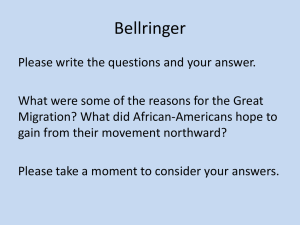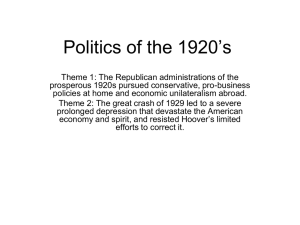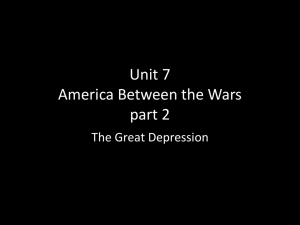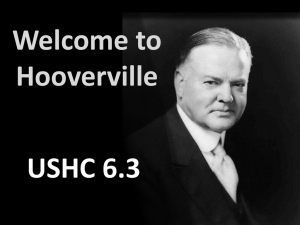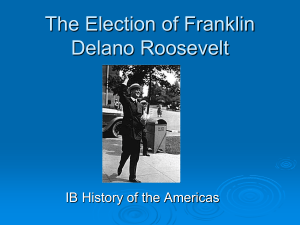Causes of the Great Depression and the Dust Bowl
advertisement
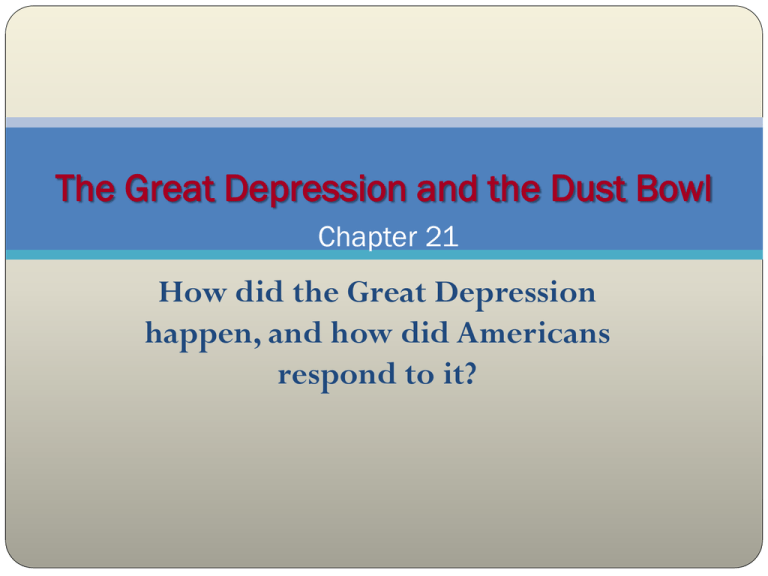
The Great Depression and the Dust Bowl Chapter 21 How did the Great Depression happen, and how did Americans respond to it? Causes of the Depression Section 1 How did the prosperity of the 1920s give way to the Great Depression? Vocabulary: -Herbert Hoover business cycle -speculation Great Depression -Black Tuesday Hawley-Snoot Tariff Standards SSUSH17 The student will analyze the causes and consequences of the Great Depression. Element: SSUSH17.a Describe the causes including over production, under consumption, and stock market speculation that led to the stock market crash of 1929 and Great Depression. Element: SSUSH17.b Explain the impact of the drought in the creation of the Dust Bowl. Element: SSUSH17.c Explain the social and political impact of widespread unemployment that resulted in developments such as Hoovervilles. Causes of the Depression Prosperity Hides Troubles Main Idea: In the late 1920s most Americans were confident in the economy, but financial problems were starting to appear. The Stock Market Crashes Main Idea: By October of 1929, the stock market began to slide downward and finally crashed, causing investors to lose millions of dollars. The Great Depression Begins Main Idea: The stock market crash led to bank failures, business shutdowns, unemployment, and eventually impacted the world economy. What Caused the Great Depression? Main Idea: A combination of factors led to the Great Depression, but there is still debate on the exact cause. Danger Signs! Herbert Hoover Mining engineer Secretary of Commerce for Harding and Coolidge Believed in cooperation between labor and management Elected in 1928 as a Republican Economy seemed robust, but problems were under the surface Farm Problems Farmers made up ¼ of workforce Falling farm prices mean farmers could not pay off debts incurred during World War I! Production remained high due to mechanization A series of draughts and other problems mean that farmers have a very hard time surviving! Rural depression in the 1920s with farmers unable to buy new consumer goods Workers’ Problems Workers work long hours with wages inching up only 8% Rich became much richer, while industrial workers were less poor Uneven prosperity of the 1920s The rich are getting richer while the poor are getting poorer In 1929, 200 companies controlled 49% of US industry. No free market competition! 71% of Americans earn less than $2500/year Income Distribution, 1929 $10,000+ $6,000-$9,999 $5,000-$5999 $4,000-$4,999 $3,000-$3,999 $2,000-$2,999 Under $1,999 Too many goods, too little demand Warehouses are full of goods that can’t be sold in a saturated market. Which, by the way, is not helped by isolationist approaches to international diplomacy! Overproduction slows industry - without markets for goods, producing more is just silly. So, we produce less Buying on credit Americans are buying goods whose value is more than they can afford! Installment plans allow consumers to buy a good and pay for it over time This increase of personal debt makes consumers more dependant on an income – if there’s no income, than they won’t be able to pay for the goods they’ve already “bought”. The Age of Credit Buying Begins in the 1920s Remember that your monthly income is about $200, and you must pay for rent, food, car, gas, utilities, etc. !!! Vacuum Cleaner, $28.95 Refrigerator, $87.50 Washing Machine, $97.50 Bedroom Suite, $228.00 $2 down, $4 a month $5 down, $10 a month $5 down, $8 a month $15 down, $15 a month Easy Chair, $38.50 Sofa, $74.50 Piano, $445.00 $5 down, $5 a month $5 down, $8 a month $15 down, $12 a month Phonograph, $43.50 Large Rug, $148.50 Corner Cabinet, $37.95 $5 down, $5 a month $10 down, $15 a month $5 down, $5 a month GRAPH Consumer Debt, 1921-1929 TRANSPARENCY Political Cartoons: Stock Market Crash Playing the Stock Market The market was advertised to new investors as a way to “get rich quick” New investors did not learn about the potential risks involved, and did not realize that the stocks they owned could be devalued and were less safe than if they had money in a bank! Why is 1929 the year everything bad happens? Speculation – investors gambling in stock market by buying on margin Black Tuesday, October 29, 1929, the bottom fell out of the stock market Stock market collapsed in the Great Crash Business cycle – periodic growth and contraction of the economy Crash market the beginning of the Great Depression, a period lasting from 1929 to 1941 “Everybody ought to be rich” Dow Jones Industrial Average moves from 91 to 313 by March, by September DJIA is up to 381 Black Thursday – October 23. The stock markets experience a $3 Billion loss in a single day! Bankers pool their money to buy more stock. Stability is important and they hope they can help.. Black Tuesday – October 29. Investors pull all their money out of the market if possible. Total Loss = $30 Billion After the Great Crash… Comes the DEPRESSION!!! Banks Close -Banks closed their doors when they could not return the money that people had deposited there… -But there was no consumer protection if money was in a failed bank, so many people just lost all their money and couldn’t do anything about it. -Misguided monetary policy – Federal Reserve had too little money in circulation, resulting in banks forced to close PM TRANSPARENCY Progress Monitoring Transparency Businesses Close and Unemployment Rises Businesses closed plants and laid off workers In 1931, Ford closed several factories, putting 75,000 workers out of work Consumers spent less, so businesses cut production even more By 1933, 25% of American workers were out of work Other Problems of President Hoover Hawley-Smoot Tariff – highest import tax in history backfires! Other countries raise their taxes also, results in a slowdown of international trade Bonus Army – WWI veterans march on Washington, DC. They wanted payment of bonus promised in 1945. NOTE TAKING Reading Skill: Recognize Causes Effects on the World No American Investment in Germany meant they could not make reparations payments, which meant the Allies weren’t paying their debts. Europeans could no longer afford to buy American goods Started a downward spiral in the global economy… DIAGRAM Worldwide Depression NOTE TAKING Reading Skill: Recognize Sequence Americans Face Hard Times Section 2 How did the Great Depression affect the lives of urban and rural Americans? Vocabulary: -bread line Dust Bowl -Hooverville Okies -tenant farmer repatriation Americans Face Hard Times Misery and Despair Grip America’s Cities Main Idea: Millions of Americans lost their jobs and were affected by poverty and hard times during the depression. Poverty Devastates Rural America Main Idea: Droughts caused those in rural areas to suffer even more during the depression and many farmers who lost their land were forced to migrate to new regions. Few Americans Escape Hard Times Main Idea: The depression touched almost all Americans in some way, as poverty and suffering spread across the country. Continued… If there’s no way like the American way, then what’s behind this box? GRAPH The 1930's American Economy INFOGRAPHIC Effects of the Great Depression Effect on Families -Families all moved in together -The divorce rate significantly decreased; people could not afford to live apart from their families -Companies would not hire women whose husbands did not have jobs – they figured that they’re more likely to move for the husband to find work and did not want to invest in an employee who would be temporary -bread lines - handouts Hoovervilles The people lowest on the economic ladder took the hardest hit. In 1932, they estimated the homeless in NY City alone was 15,000. Homeless people built shanty towns with tar paper, cardboard, or scrap metal. These came to be known as Hoovervilles. The people blamed the president for the crisis. Poverty in Rural America Commodity prices plunge Many farmers lost farms and moved Between 1930 and 1934, nearly one million farmers lost their farms Some became tenant farmers The Dust Bowl -Extreme drought and dust storms through much of the 1930s significantly harmed agricultural interests -Living in the Midwest became extremely difficult! -Okies – name for Dust Bowl refugees; most Okies went to California, Oregon, or Washington -Commercial farms grew -Dams on western rivers brought irrigation to the Great Plains PM TRANSPARENCY Progress Monitoring Transparency CHART The Great Plains, 1929-1939 TRANSPARENCY The Dust Bowl Minorities U.S. government tightened the rules to obtain a visa, targeting Mexican Americans More than 300,000 Mexicans and Mexican Americans were coerced into leaving the U.S. between 1930 and 1935 African Americans were “were the last to be hired and the first to be fired” NOTE TAKING Reading Skill: Categorize Hoover’s Response Fails Section 3 Why did Herbert Hoover’s policies fail to solve the country’s economic crisis? Vocabulary: -localism -RFC -trickle-down economics -Douglas MacArthur Hoover Dam Bonus Army Hoover’s Response Fails Cautious Response to Depression Main Idea: Hoover originally responded to the depression by encouraging volunteerism and asking local governments to intervene, but these methods failed. Hoover Adopts More Activist Policies Main Idea: Hoover took stronger action and gave federal money to banks and businesses, but little of this money reached the people. Americans Protest Hoover’s Failures Main Idea: Many Americans were unhappy with Hoover's response to the depression. One group, known as the Bonus Army, led a protest march in hopes of getting help from the government. Herbert Hoover Hoover followed a hands-off policy Volunteerism: asked businesses to keep employment at current levels Asked government to reduce taxes, lower interest rates, and create public-works programs; volunteerism failed NOTE TAKING Reading Skill: Identify Supporting Details TRANSPARENCY Building the Hoover Dam GRAPH Hoover Dam Energy Use Protests Some rejected capitalism and accepted socialism or communism Bonus Army marched on Washington; World War I veterans who sought a bonus promised to them in 1945 20,000 camped out in Washington Hoover ordered General Douglas MacArthur to clear the veterans; used force, causing injuries Ended Hoover’s chance for reelection in 1932 INFOGRAPHIC The Bonus Army Election of 1932 % of the Popular Vote Electoral College Votes Roosevelt 57.4 472 Hoover 39.7 59 Roosevelt wins in 42 states with votes from upset citizens, while Hoover only won 6 states! Roosevelt’s first inaugural address: March 4, 1933 The only thing we have to fear is fear itself… Roosevelt’s “New Deal” His proposal to relieve the stresses of the Depression with government involvement and several new agencies to protect consumers and investors. (more info coming later…) Roosevelt’s Secret Weapon… His wife Eleanor – a very public figure involved in participating in the life of the country and talking to the people No one can make you feel inferior without your consent… You gain strength, courage, and confidence by every experience in which you really stop and look fear in the face… Roosevelt’s Fireside Chats A series of Sunday night radio addresses to the nation Gave info on policy, diplomacy, and current issues TRANSPARENCY The Great Depression PM TRANSPARENCY Progress Monitoring Transparency


